In the world of vintage Gibson Les Pauls, you probably heard or read about PAF pickups. But what exactly is a PAF pickup, and what do they sound like?
Also known as “Patent Applied For”, Gibson PAF humbucker pickups from the 1950s are renowned for bringing out the best of Les Paul guitars and providing that warm low end, clear mids and crisp highs, bell-like tones that very few other guitar pickups can match.
If you had a pair of original PAFs and installed them on a modern Les Paul, they would get you very close to that authentic vintage Gibson Les Paul tone from the late 1950s. Here are a few sound clips of what a Gibson Les Paul Reissue with original 1959 PAF humbuckers sounds like using all three pickup selectors (Neck/Rhythm, Middle, and Bridge/Treble positions):
Read on and learn more about how these sought-after humbuckers became popular within rock and blues music, and why they are still used by so many electric guitar players around the world today.
Brief History & Development
When Gibson, with the help of Walter Fuller, created and introduced the single-coil P-90 pickups after the First World War in 1946, it sounded great and all but they had a common problem shared with other electric guitars at the time (e.g. Telecaster). That problem was the humming or “noisy” sounds they produced when the volume was raised, especially on a solidbody guitar like the Les Paul. This is often referred as a 60 cycle hum.
So, what was the solution to this?
By late 1954, Gibson’s engineer, Seth Lover, came up with a way to eliminate the hum by using two single coils, instead of one, and the result was a quiet and hum-free pickup. Gibson called it the humbucking pickups, or humbuckers, and they patented the technology on June 22, 1955.
The first Gibson electric guitars to come equipped with humbucking pickups was the early 1957 ES-175, even though they didn’t have the “Patent Applied For” decals on them.
In mid-to-late 1957, their humbuckers had decals or stickers that said “Patent Applied For” on them until the patent was granted in July 1959. However, Gibson continued to use the PAF decals, and it wasn’t until 1963 that they completely stopped using them and shifted to using decals that said “Patent No 2,737,842” instead.
The supply of pickups with the PAF decals on them lasted until mid 1962, and one of the last Gibson electric guitars that you would typically see equipped with them, is the early Gibson SG.
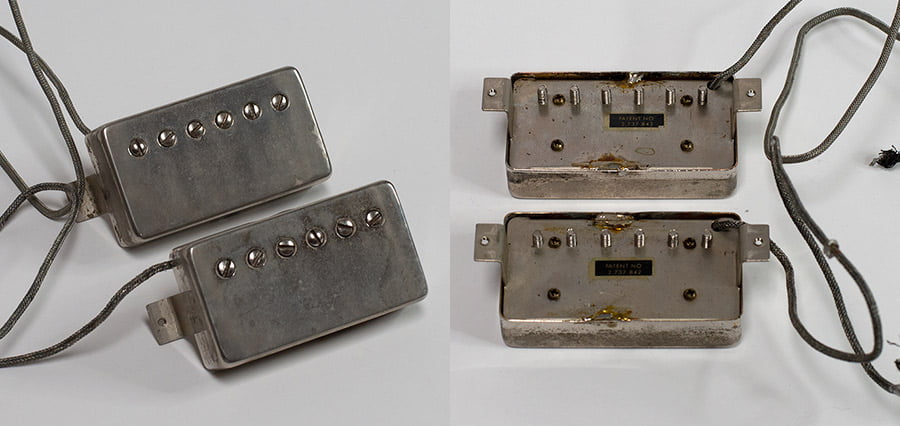
Inside A PAF Humbucker Pickup
From the outside, a vintage PAF humbucker with its cover on may look like nothing but a regular guitar part. But inside, it’s a whole different story, and you’re going to learn what makes these sought-after 1950’s Gibson pickups sound like they do.
The Bobbins
The bobbins inside a PAF pickup were made from Butyrate plastic, which was a commonly used plastic in the 50’s, and they originally came in black color. Sometime around spring 1959 (around the ‘9 0600’ serial), cream-colored bobbins started to appear after the plastic supplier ran out of black ones. So, around this time, some PAF humbuckers came with black and cream bobbins (aka “zebras”), or both in cream (aka “double whites”). This lasted until mid 1960 when the original black bobbins were back in stock.
If you were to take a first look at the bobbins of a vintage PAF, they may appear to be perfect and identical in size. But, these bobbins will be slightly warped from the tight pickup winding they did back then. Some believe it is the bobbin’s Butyrate plastic, warping and unevenness that contributes to the “PAF” sound.
Interesting fact: The odor vintage bobbins give off is often described as similar to “sour milk.”
The Wire
The bobbin wire Gibson used in the 50’s was 42 AWG plain enamel copper magnet wire, and they were purplish in color. Some of the later PAF and Patent Numbered pickups had reddish wire, though.
Number of Winds
When we’re talking about windings and how many winds each coil of a PAF bobbin got, just know that it’s not set in stone. That’s because, back in the day, the ladies at Gibson didn’t consistently watch the winding process all the time, so you’ll find some variations.
However, it’s generally accepted that the PAF pickup had around 5,000 windings per coil, or a ballpark figure of 10,000 turns with #42 plain enamel wire for the whole deal.
The Magnets
Gibson used these 2.5″ long magnets they called “rough cast.” They got that name because after these magnets were cast, no one bothered to give them a polish. They used Alnico magnets, a mixture of Aluminum, Nickel, and Cobalt, and came in grade 2, 3, 4 or 5. These magnets were part of the PAF pickup from the get-go, starting in ’57 up until about ’60.
Here’s a list of the changes Gibson made to their PAF pickups over time:
1956 – Early 1957
- Gibson used long Alnico 2, 3, 4, or 5 grade magnets in PAFs. These 2.5” long magnets were also used for their P-90 pickups. Alnico stands for the metallic elements: aluminum, nickel and cobalt. Gibson lap-steels first used them in ‘56 followed by guitars, including the Les Paul, in ‘57.
- Purple-colored #42 plain enamel wire was used to wind them.
- DC resistance measured between 7.5k ohms and 9.0k ohms.
- Brushed stainless steel covers were used.
- No “Patent Applied For” decals.
Mid-1957 – 1960
- Long Alnico 2 magnets commonly used (but not always)
- Nickel covers were used.
- “Patent Applied For” decals.
Mid-1961 – 1962
- Smaller 2.37” long Alnico 5 grade magnets were normally used (with some being used as early as 1960).
- DC resistance averaged 8.0k ohms by ’62.
Mid-1962 – 1963
- Alnico 5 magnets commonly used.
- Reddish/Copper colored enamel wire.
- DC resistance measured around 7.5k ohms.
- “Patent No 2,737,842” decals.
1963 – 1965
- Polyurethane coated wire was used.
1965 – 1968
- Instead of using a manually-run winding pickup machine, they switched to one that’s fully automated, which made the DC resistance to be at a consistent 7.5k ohms.
- Orange colored wire
- Chrome covers
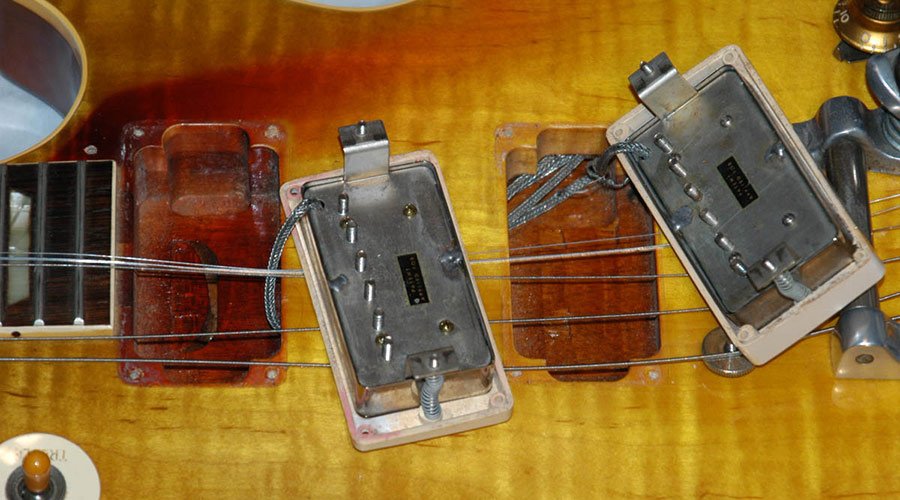
The PAF Tone Characteristics
While the original P.A.F pickups got rid of the hum, they are still microphonic in a way. That’s because they weren’t wax potted to begin with, unlike the modern ones that are wax potted. This means that the older humbuckers are sensitive to any touch (e.g. taps, scratches) on the guitar, resulting in vibrations and harmonics.
Compared to the modern humbucking pickups, the vintage PAFs create a slightly more open and uncompressed sound that is not as bright as the single-coil P-90s, and they have these warm lows and clear woody tones.
PAF Dual-coil vs P-90 Single-coil Differences
While both of these vintage pickups sound amazing, they do have minimal differences when it comes to tone, and big differences when it comes to their structure.
For starters, the PAF humbuckers typically come encased in metal covers, in either nickel or chrome, and there will be 6 adjustable pole pieces with slotted heads (for each guitar string) on them. It’s not uncommon to see them uncovered, exposing their two bobbins side by side which are colored in double whites, double blacks, or zebras (white and black).
The P-90s, on the other hand, have these cream plastic (butyrate) covers. They look like the ones found in a Stratocaster. People would often describe P90s as having this ‘soap bar’ look. The color of the bobbins came in black only.
The PAF humbuckers use two coils, making them sound warm and articulate, whereas the P90 uses just one, making them sound angry and gritty (and hum in high-gain situations).
In other words, one individual (PAF) enjoys life in the hills, drinking champagne and fine wines, while the other (P90) is from the poor side of town, leading a tough life and drinks whiskey and beer.
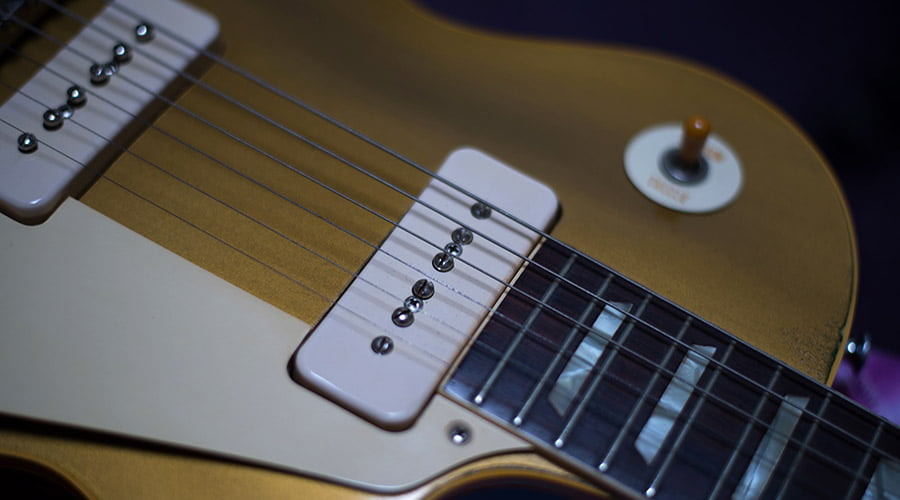
P.A.F vs Modern Humbucker Differences
What sets the vintage PAF pickups apart from the modern ones, is that they don’t lose any definition and clarity of sounds your Les Paul produces when the guitar volume is turned down. They are incredibly versatile, work for almost any style of music, and have this sweet sustain (from the lower output) that is not over the top like the modern humbuckers (stronger output). The reason for this mainly has to do with the “weaker” Alnico magnets used in the ’50s, resulting in a less magnetic pull on the strings (lower output).
Gibson Guitars That Came With PAF Pickups
Below are the Gibson guitars that used P.A.F. pickups:
1957 – 1960
- Gibson Les Paul Standards and Customs, ES-175, ES-295, Byrdland, ES-5 Switchmaster, L-5CE, Super 400, ES-335, ES-345, ES-350, and ES-355.
1961 – 1962
- Gibson SG, L-5 CES, ES-175D, Super 400, ES-335, ES-345, ES-350, ES-355, Barney Kessel Regular/Custom, and Byrdland.
How to Identify PAF Pickups
Without taking covered PAF pickups apart, here are some key identifiers to look for:
Decals
- On the back of the PAF, look at the “Patent Applied For” black decal and make sure the gold lettering is raised.
- Around the same black decal, there should be a “clear” stripe or edge with a greenish tint to it. Sometimes the clear stripe would get worn but you should still see some green flecks in the area.
- Keep in mind that the early 1957 PAF pickups with stainless steel covers did not have any decals on them.
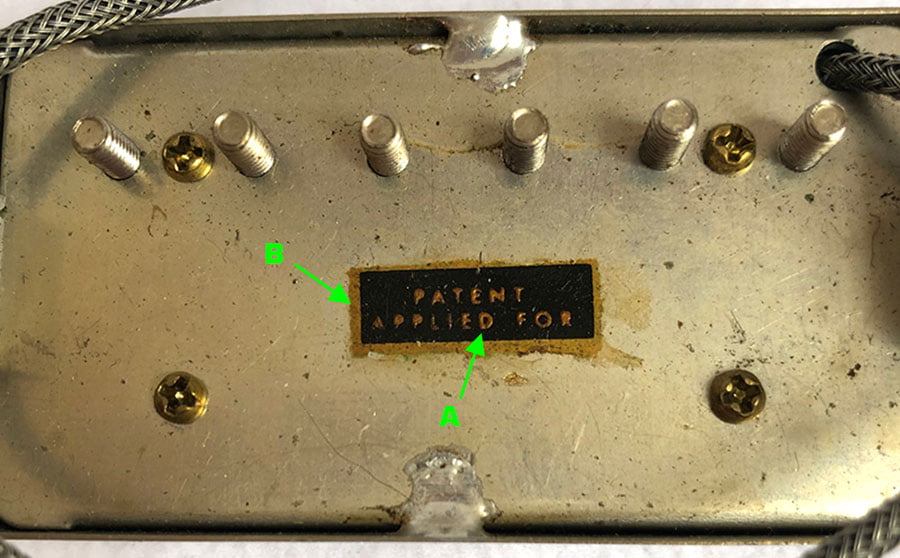
Tooling Marks
- If you look at the back, there should be “L” shaped tooling marks on the feet of the PAF. This is another detail that helps verify the authencity of vintage PAF humbuckers.
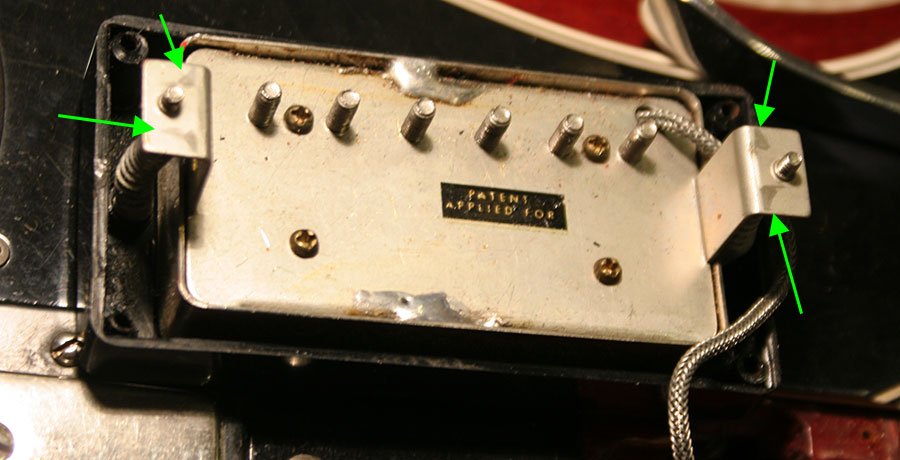
Famous PAF Guitar Players
- Kirk Hammett bought the Peter Green/Gary Moore 1959 Gibson Les Paul (aka Greeny) in 2014, and has since played it extensively in the studio and during live performances.
- Joe Bonamassa is probably one of the biggest vintage Gibson guitar collectors, and he is well known for playing different PAF Les Pauls when performing live.
- Marcus King plays an all-original 1962 Gibson ES-345 in cherry finish that was handed down to him by his grandfather.
- Jason Isbell has an impressive collection of rare guitars, and the famous one is the 1959 Gibson Les Paul Standard Burst dubbed “Red Eye”, which was once owned and played by Lynyrd Skynyrd guitarist Ed King.
Current Value of PAF Pickups
As of 2025, a clean set of vintage Gibson PAFs from the desirable years (1957-1960) can be had for about $20,000, or more. Factors like the condition that they’re in, whether they were tinkered with or repaired in the past, will affect the price obviously. It was only several years ago (2020) when a nice set of 1959 double whites with covers can be had for only $10,000. It’s the same PAF set played in the video above.
Gibson’s 1959 PAF Humbucker Pickups in 2024
In mid-January 2024, Gibson announced a limited edition reissue of their 1959 PAF humbucker pickups at NAMM. They’re calling it the ‘1959 Collector’s Edition Series 1’. The price tag for a set of these puppies is $999, and only 1,000 sets will be made.
Of course, with every reissue they come out with, like their True Historic ’59 Les Paul, they are promising the most authentic recreation of that 50’s low output, warm and woody tone we all came to love. A set of these unpotted PAF reissues will come with:
- Alnico 4 magnets
- Two-conductor wiring
- Double white butyrate bobbins
- 42 AWG plain enamel wire
- “Patent Applied For” stickers
- True Historic nickel covers
- True Historic cream pickup rings
- Small Lifton presentation case
How will they compare with other high-end boutique PAF pickups? Only time will tell, but so far Gibson is claiming to have done everything they can to reverse engineer, including doing 3D scanning, of original “Patent Applifed For” humbuckers they have access to.
One thing’s for sure: there’s no doubt these limited edition PAF pickups will be sold out when they become available on their website, and it won’t be long before they come up with a “Series 2” edition. A Murphy Lab-aged collection with scratches and tarnish, perhaps?
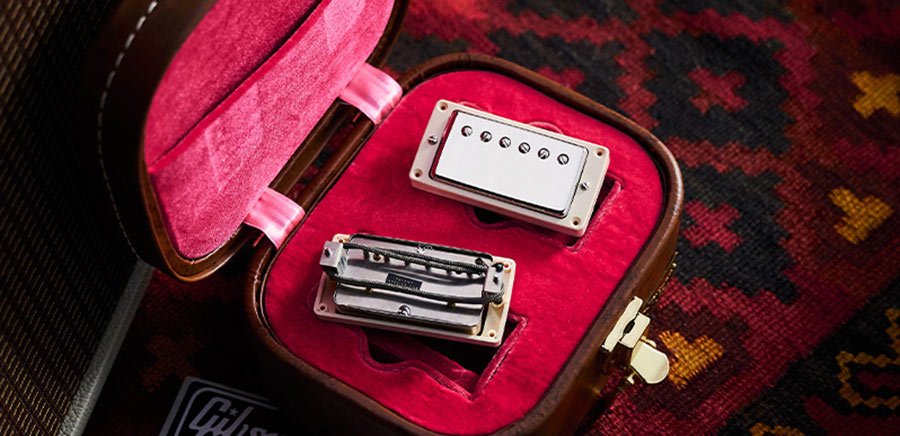
Final Thoughts
Even after many years since Gibson first introduced the Patent Applied For pickups to the music world in 1956, they are still sought after by many guitar players and collectors alike. While it’s becoming harder to find an unmolested set of vintage PAF pickups, there are other modern PAF-style humbuckers that you can choose from that will get you close to that 1950’s tone.
Frequently Asked Questions
Were vintage PAFs wax potted?
No. The wax potting of pickups was not common until the 1980’s.
What does PAF mean in pickups?
P.A.F. is short for “Patent Applied For”.
Can you put PAF humbuckers in a Telecaster?
Yes, but the Telecaster body cavities would need to be re-routed so that the larger sized humbuckers can fit.
Share your thoughts in our forum! 💬
👉 Introduce yourself and show off your Les Paul and other gear.
Share this post with your friends using these one-click sharing options:
👉 Click here to share on Facebook.
👉 Click here to share on X.
👉 Click here to share on LinkedIn.
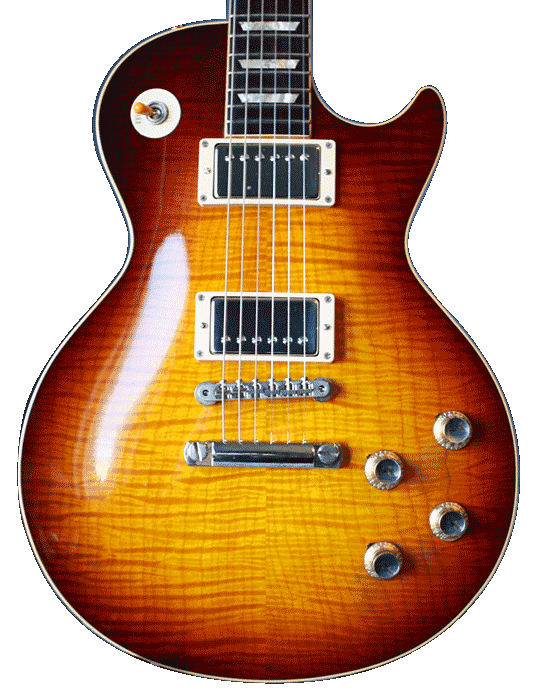
Get the latest reviews, guides and videos in your inbox.